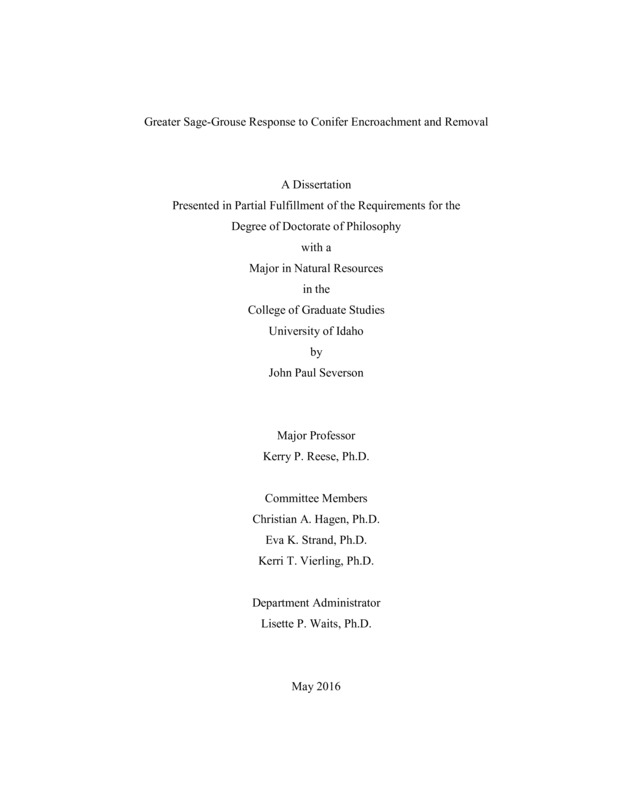Greater Sage-Grouse Response to Conifer Encroachment and Removal
Severson, John Paul. (2016). Greater Sage-Grouse Response to Conifer Encroachment and Removal. Theses and Dissertations Collection, University of Idaho Library Digital Collections. https://www.lib.uidaho.edu/digital/etd/items/severson_idaho_0089e_10915.html
- Title:
- Greater Sage-Grouse Response to Conifer Encroachment and Removal
- Author:
- Severson, John Paul
- Date:
- 2016
- Keywords:
- conifer encroachment juniper restoration sagebrush sage-grouse
- Program:
- Natural Resources
- Subject Category:
- Wildlife conservation; Wildlife management; Conservation biology
- Abstract:
-
Conifer woodlands expanding into sagebrush (Artemisia spp.) ecosystems are a threat to sagebrush obligate species including the imperiled greater sage-grouse (Centrocercus urophasianus). Sage-grouse are an obligate sagebrush species that has decreased in abundance and distribution amidst the declining sagebrush biome. Conifer removal has been recommended as a conservation strategy and is accelerating rapidly despite a lack of empirical evidence on outcomes to grouse. My objective was to assess the spatial and temporal effects of conifer encroachment and removal on sage-grouse ecology including nest-site selection, seasonal habitat selection, nesting habitat succession, nest survival, and annual female survival in the northern Great Basin from 2009–2014. Land management agencies removed ~10,000 ha of encroached conifer from 2012–2014. I monitored >350 female sage-grouse and nests in both a treatment area and a control area before and after treatments.
I estimated reduced nest-site selection above a threshold of 3% conifer canopy cover at a scale of 800 m, while a before-after-control-impact (BACI) analysis of conifer removal showed increased nesting in treated areas through time indicating increased nesting habitat availability. I assessed effects of conifer encroachment and removal on nesting habitat characteristics including shrub and herbaceous abundance and richness. Increased conifer cover negatively impacted several key nesting characteristics, while conifer removal increased the suitability of nesting habitat. Additionally, assessment of female habitat selection showed conifer avoidance throughout the year at a scale of 400 m around telemetry locations. Conifer removal increased habitat availability most in the summer when sage-grouse and their broods move higher in elevation during the hot, dry weather to more productive sites that are also most susceptible to conifer encroachment. Model averaged estimates of female survival and nest survival in a BACI analysis showed some indication of increases through time in the treatment area relative to the control.
This is the first study to evaluate effects of conifer encroachment and removal on habitat selection and survival throughout multiple life history stages of sage-grouse. I observed negative effects of conifer encroachment on habitat selection. Conifer removal increased habitat availability at a landscape-scale, potentially resulting in increases in demographic parameters important to population growth. This study will be crucial in evaluating the efficacy of conifer removal for sage-grouse conservation and how management can be focused to maximize benefits.
- Description:
- doctoral, Ph.D., Natural Resources -- University of Idaho - College of Graduate Studies, 2016
- Major Professor:
- Reese, Kerry P
- Committee:
- Hagen, Christian A; Strand, Eva K; Vierling, Kerri T.
- Defense Date:
- 2016
- Identifier:
- Severson_idaho_0089E_10915
- Type:
- Text
- Format Original:
- Format:
- application/pdf
- Rights:
- In Copyright - Educational Use Permitted. For more information, please contact University of Idaho Library Special Collections and Archives Department at libspec@uidaho.edu.
- Standardized Rights:
- http://rightsstatements.org/vocab/InC-EDU/1.0/

